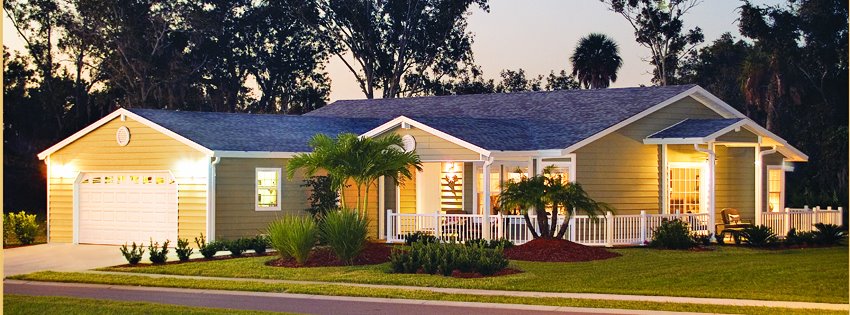Landscaping is an essential step for enhancing the curb appeal of your Florida manufactured home. With some simple planning, you can design a low-maintenance yard that you and your family will enjoy for years to come.
Start with a simple sketch of the footprint of the manufactured or modular home and indicate where the front door, driveway, utility boxes, sidewalks, fences (if applicable) and any other notable features are located in the four corners of your yard. Establish the direction the door faces in regard to sun exposure. Planning a landscape must include matching plants with the right site conditions based on sun and wind exposure, irrigation, and proximity to bodies of salt water. Visit your local garden shop and take note of the surrounding mobile home community to get an idea of plants that are growing successfully in the area. Always invest in landscaping that is recommended for your climate zone.
Front Door
The front door is a focal point so the surrounding area should be low maintenance with good drainage. The plant beds should curve away from the arc of the building and flow into the angles of the dwelling or walkway. Always leave a gap between the house and plants. Plan the space for plants reaching their mature size.
At the front of the Florida manufactured home, plant low growing foundational plants and flowers that do not obscure any windows. A low grass like mondo and small shrubs like varieties of ixora, firebush, or Dwarf Walter viburnum can be easily maintained. Simple flower beds of vincas, purslane or small daisies bordered by texture plants like coleus, Persian shield or variegated flax lily are ideal. For annuals, large groupings of salvia, begonias, impatiens, dianthus and alyssum provide beautiful color and texture. If the front door faces north, consider combination plants that also tolerate shade like sanchezia, crossandra, coleus and bloodleaf.
Borders and Walkways
Outside of planting beds, fill in the manufactured home landscape with hardy grass like Bahia, St. Augustine or Zosia. Link the planted spaces with repeating plant patterns and rows of low-growing plants as borders. A walkway can guide the design of plant groupings. Varying the heights and textures of groupings creates visual interest. Expanses of the same or similar plants helps unify the design. Utilize a strip of turf or raised edging to keep mulch off of walkways during rain showers.
Low Lying Areas
If the Florida property has an area that stays consistently wet, a rain garden could be designed incorporating varying sizes of rocks and boulders as a lining along with moisture-loving plants to create a focal point.
Trees
Use trees to provide a sense of scale and to act as a shade screen. Small trees can be used leading up to an entrance way to enhance the view and draw the eye to the next flower bed. Crepe Myrtles, Bottlebrush and small palms are ideal as a single specimen plant. Position trees for shade on the south, east and west sides of a house to help keep the energy costs down. To create screening for privacy along a fence row, use upright evergreens or trees with a spreading canopy. Larger trees can be positioned in groupings near the corners or sides to frame the property.
Other Tips
Watering – Underground irrigation systems should be installed before plants. Per Florida law, you must maintain an active rain sensor to prevent automatic watering during rainy conditions. Morning is the optimal time to water plants and do not water if rainy conditions are occurring within a 24-hour period.
Mulch – Mulching is essential for maintaining soil moisture and discouraging weeds. Mulch can be purchased and/or created by recycling fallen leaves for self-mulching bed areas.
Attract Wildlife – Bees, bats and birds are beneficial to the environment by eating insects and providing pollination. Invite these creatures by planting flowers, trees and berry bushes.
Pruning – The experts advise never removing more than 30 percent of the foliage at one time. Plant pruning is intended to remove deadwood, thin excessive growth or reduce height or spread of a plant or tree. Read up on your plant for the optimal conditions and technique for any suggested pruning.
Landscaping, especially in warm climates like Florida, can be very rewarding. A beautiful yard not only enhances your property, it can keep you active and enjoying the great outdoors.
Source: University of Florida, Institute of Food and Agricultural Sciences, edis.ifas.ufl.edu

